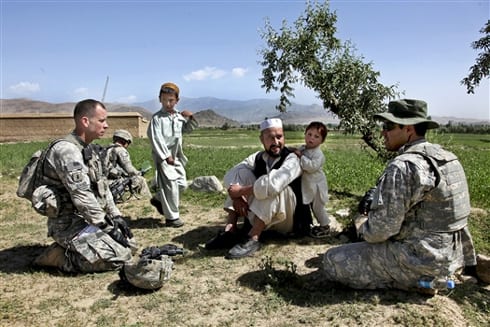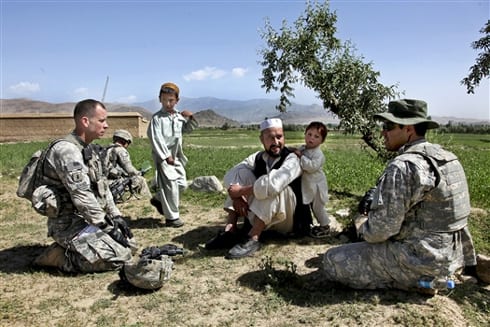In Vietnam, the United States fought a counterinsurgent war on behalf of a government lacking popular legitimacy using primarily conventional tactics in support of a flawed strategic objective that turned out to be inconsequential to the broader Cold War struggle against Communism. The primary lesson learned, particularly within the Army, was “never again.”
However, a decade ago, a cadre of officers well schooled in irregular warfare and intrastate conflicts, eventually marshaled by General David Petraeus, scrambled to rearticulate the lost principles of counterinsurgency deliberately buried after Vietnam, incorporate them into a new Army doctrine and apply them (appropriately) in Iraq and (less so) in Afghanistan.
This experience is compellingly detailed in Fred Kaplan’s book, The Insurgents: David Petraeus and the Plot to Change the American Way of War.
Kaplan cautions whether the military is capturing the right lessons or adequately incorporating them into future planning. Coupled with the Obama administration’s understandable reluctance after unwinding two wars to engage in large-scale interventions any time soon, the risk is that the military will walk away from counterinsurgency doctrine when the war in Afghanistan ends next year, just as it did after Vietnam.
 The Insurgents offers several strategic lessons regarding the nature of future conflict; how the United States should wage war; and key factors that will determine success or failure.
The Insurgents offers several strategic lessons regarding the nature of future conflict; how the United States should wage war; and key factors that will determine success or failure.
The first is the preeminence of political rather than military outcomes. As Kaplan relates, Petraeus adopted the dictum that counterinsurgency is 80 percent political and 20 percent military. That is likely to be true with any future intervention.
The United States entered Afghanistan and Iraq knowing what it wanted to eliminate – Osama bin Laden’s sanctuary and Saddam Hussein’s regime – but with only a vague conception of a desired strategic end state. In Iraq, the lack of a post-conflict strategy was not an oversight, but deliberate. In neither case was there a grasp of the political, social and cultural forces in those countries that would shape the eventual outcomes.
Regime change is not the end of the war, only the end of the first phase. The desired end state, a government with perceived legitimacy that earns the support of a large cross-section of the local population, is very difficult. This is not only clear from the mixed results achieved in Iraq and Afghanistan, but Libya as well.
An effective plan for the conflict and what happens afterwards requires integrated civilian and military action, a second lesson. This rarely happened over the past 12 years. While there was an effective partnership in Iraq between Petraeus and Ambassador Ryan Crocker, the norm involved civilians and the military pulling in different directions. The worst case involved Paul Bremer’s ill-advised orders regarding the disbanding of the Iraqi Army and de-Ba’athification of the government, uncoordinated steps that fueled if not generated the insurgency.
Future interventions will involve a “whole of government” effort, involving not just soldiers and diplomats, but development experts in wide-ranging fields from agriculture, policing and justice to energy, commerce and communication. Unfortunately, the United States government is not structured to plan or naturally operate that way. As it is, Congress fully funds only one element of national power, the military. Given the military cuts associated with sequestration, Congress over time may be tempted to restore some of them with offsets from non-defense discretionary accounts. If so, this will only widen the gap between military and civilian capabilities.
The third lesson regards time. Wars of insurgency are by nature “slow and messy.” Kaplan questions whether the American people are unwilling to support such long, complicated and costly endeavors.
While this remains a richly debated field of study, the American people gave its leaders 12 years to succeed in Afghanistan and eight years in Iraq. While some have already argued the military has been withdrawn too quickly, the fact is the United States squandered too much time developing workable strategies and putting appropriate levels of resource in place.
Going forward, any intervention will be a race against time. Better strategic planning is an imperative. Given the emerging global media environment, the perceived legitimacy of any action is on the clock with no time to waste.
Given how lethal force can be delivered through more technology and fewer troops, future Presidents will be tempted to solve the time problem by engaging in high-tech wars without mobilizing the American people or the government. But given the proliferation of smartphones with cameras linked to the Internet and social media like Facebook and Twitter, future warfare will still be influenced by public opinion. Governments may choose to ignore the impact, as is happening now in Pakistan, but public pressure can be expected to increase, overseas if not at home.
The final lesson is simple, yet compelling. If we are not confident that military action can be decisive, the most prudent decision may be not to intervene militarily in the first place. This is certainly not easy with various constituencies calling on the United States to “do something.” But the reality is that, if future conflict is mostly political, military action may incur profound costs without actually solving the problem.
This appears to be the one lesson that has been put into practice. The result, right or wrong, is evident in Syria.


